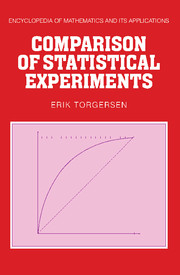Book contents
- Frontmatter
- Contents
- Preface
- Acknowledgments
- 1 Statistical experiments within the measure theoretical framework
- 2 Convexity
- 3 Two-person, zero-sum games
- 4 Statistical decision problems
- 5 Vector lattices
- 6 Deficiencies
- 7 Equivalence, representations and functionals of experiments
- 8 Comparison of linear models
- 9 Majorization and approximate majorization
- 10 Complements: Further examples, problems and comments
- List of symbols
- Author index
- Additional references
- Subject index
Preface
Published online by Cambridge University Press: 05 May 2013
- Frontmatter
- Contents
- Preface
- Acknowledgments
- 1 Statistical experiments within the measure theoretical framework
- 2 Convexity
- 3 Two-person, zero-sum games
- 4 Statistical decision problems
- 5 Vector lattices
- 6 Deficiencies
- 7 Equivalence, representations and functionals of experiments
- 8 Comparison of linear models
- 9 Majorization and approximate majorization
- 10 Complements: Further examples, problems and comments
- List of symbols
- Author index
- Additional references
- Subject index
Summary
This is a self-contained exposition of the theory of comparison of statistical experiments. The idea of comparing experiments by comparing the risks they produce for varying losses, developed gradually after the appearance of Wald's works on statistical decision functions. Contributions by Blackwell, Bohnenblust, Shapley, Sherman and Stein in the years 1949–1953 provided criteria for one experiment being more informative than another. In 1955 Boll showed how the comparison problem may be reduced when invariance conditions are satisfied. In 1965 Strassen generalized the dilation criterion and also provided a variety of other related and interesting results.
In the same period a considerable effort was made to clarify basic statistical concepts such as sufficiency and invariance within the framework introduced by Kolmogorov in 1933. Building on earlier works of Fisher, Neyman, Pearson and Wald these concepts were explored by Bahadur, Blackwell, Halmos and Savage, for example, and, although it was not well known at the time, by Dynkin.
Substantially broadening the scope, LeCam (1959) (see LeCam, 1964) addressed himself to the following question.
Given two experiments ℰ and ℱ, when are we justified in claiming that only so much information is lost by basing ourselves on the experiment ℰ rather than on the experiment ℱ?
It turned out that a variety of different approaches to this problem led to the same numerical quantity, the deficiency of ℰ with respect to ℱ. Thus the deficiency has natural interpretations in terms of pointwise comparison of risks, in terms of maximum risks, in terms of performance functions of decision rules, in terms of Bayes risk and in terms of randomizations.
Information
- Type
- Chapter
- Information
- Comparison of Statistical Experiments , pp. xi - xviiiPublisher: Cambridge University PressPrint publication year: 1991
